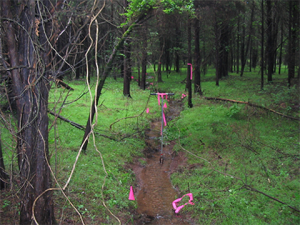WOTUS, WOTUS, Everywhere… or Not?

The proposed WOTUS definition excludes ephemeral streams like this one.
On February 14, 2019, the U.S. Environmental Protection Agency (EPA) and the U.S. Army Corps of Engineering (Corps) issued a new Proposed Definition of Waters of the U.S. (WOTUS). You’re probably thinking, “wait a minute, didn’t we just do this?” You are correct! The previous administration issued a new definition of WOTUS in 2015 that went into effect in 26 different states last year, including Maryland, Virginia, and Washington D.C. While the 2015 Rule expanded the definition of WOTUS, the 2019 proposed rule reduces the amount of wetlands and streams that are considered jurisdictional at a federal level.
What the new rule includes as WOTUS
- Tidal waterbodies and traditionally navigable waterways
- Tributary streams with perennial or intermittent flow
- Ditches that are a relocation of a tributary or are constructed in an adjacent wetland
- Lakes and ponds that contribute flow to perennial or intermittent tributaries
- Impoundments of waters
- Adjacent wetlands (defined as “wetlands that abut or have a direct hydrologic surface connection to a water identified [above]”)
What the new rule excludes from WOTUS
- Anything not specifically identified as a WOTUS (per the above)
- Groundwater
- Ephemeral features
- All other ditches not specifically defined as a WOTUS
- Artificial lakes and ponds constructed in uplands
- Water-filled depressions created in uplands
- Stormwater control features constructed in uplands
- Wastewater features
The most significant differences between the proposed definition and the 2015 Rule are the exclusion of ephemeral streams from federal jurisdiction and the revised definition of the term “adjacent” under the proposed definition. The 2015 Rule considered wetlands within 4,000 feet of a tributary to be “adjacent” and thus under federal jurisdiction. The proposed definition excludes most wetlands that are not directly “adjacent” to (i.e. directly touching), or “have a direct hydrologic surface connection to” a stream, pond, or tidal waterbody.
Geographically, there appears to be a lot of variability in terms of the proposed federal effect. Our quick analysis of several large sites indicates that there wouldn’t be much change in federal jurisdiction to many piedmont sites (±5%), but could be much larger in the Triassic basin and coastal plain (±50%).
The EPA is accepting comments on the proposed definition for 60 days, so any comments must be received by April 15, 2019.
What this means for you
This is a federally proposed rule, so it only affects what federal agencies can regulate. Both Virginia and Maryland have state wetland programs that regulate many of the features proposed for exclusion.
Virginia
Any wetlands considered isolated (not adjacent) under the proposed rule will still fall under state jurisdiction as state surface waters (which has been the case since 2001). Ephemeral streams will continue to fall under state jurisdiction if they contain an Ordinary High Water Mark, along with most ponds constructed in uplands. Perennial and intermittent ditches that possess an Ordinary High Water Mark will continue to be regulated by DEQ. If your project will impact any of these features, you’ll need to coordinate with DEQ regarding state jurisdiction, and a permit from DEQ may be needed (depending on the activity), even if you don’t need one from the Corps.
Maryland
Similar to Virginia, any wetlands considered isolated under the proposed rule will still fall under state jurisdiction per the Nontidal Wetlands Protection Act. Thus, authorization will be needed from the Maryland Department of the Environment to impact any wetlands considered isolated under the proposed rule. However, Maryland does not currently take jurisdiction over ephemeral streams.
Caution: Uncertainty Ahead
The U.S. Army Corps of Engineers does not have a standard field method for differentiating between ephemeral and intermittent streams or between intermittent and perennial streams. While a few regional methodologies exist, they are somewhat subjective (3 to 4 point differences between experienced users of the methods) and could lead to uncertainty over what the federal government is regulating in practice. This could delay the time it takes to get a jurisdictional determination, which in turn can delay permit applications.
Your Options
Comments are being accepted regarding the proposed rule until April 15, 2019. The EPA is also specifically requesting comments regarding whether intermittent streams should also be excluded from the definition of WOTUS. Let your voice be heard – we’re expecting the proposed changes will inject more uncertainly into an already flawed and lengthy process.
Questions?
If you have any questions regarding the proposed rule, or how it may affect your project please contact:
- Headquarters: Ben Rosner, Mark Headly, and Christie Blevins
- Tidewater Virginia: Bob Kerr
- Maryland: Mike Klebasko
You can read about the history of WOTUS changes in our previous Field Notes articles:
- Waters of the U.S.: New Definition Proposed, December 11, 2018
- WOTUS Definition in Limbo – EPA Delays Return to Pre-2015 Definition, November 8, 2018
- Federal Ruling Creates Delay in Corps of Engineers Process, August 23, 2018
- 6th Circuit Court Vacates WOTUS Rule Stay, April 11, 2018
(Reprinted with permission from the National Association of Home Builders. This article originally appeared in the February 28, 2018 edition of NAHB Now.) - WOTUS 2020 – EPA and Department of the Army Delay Clean Water Rule of 2015, February 23, 2018
- A Graphic Description of WOTUS – Wetlandia, July 9, 2015
- EPA and COE Redefine Which Wetlands and Streams are Federally Regulated, June 2, 2015
